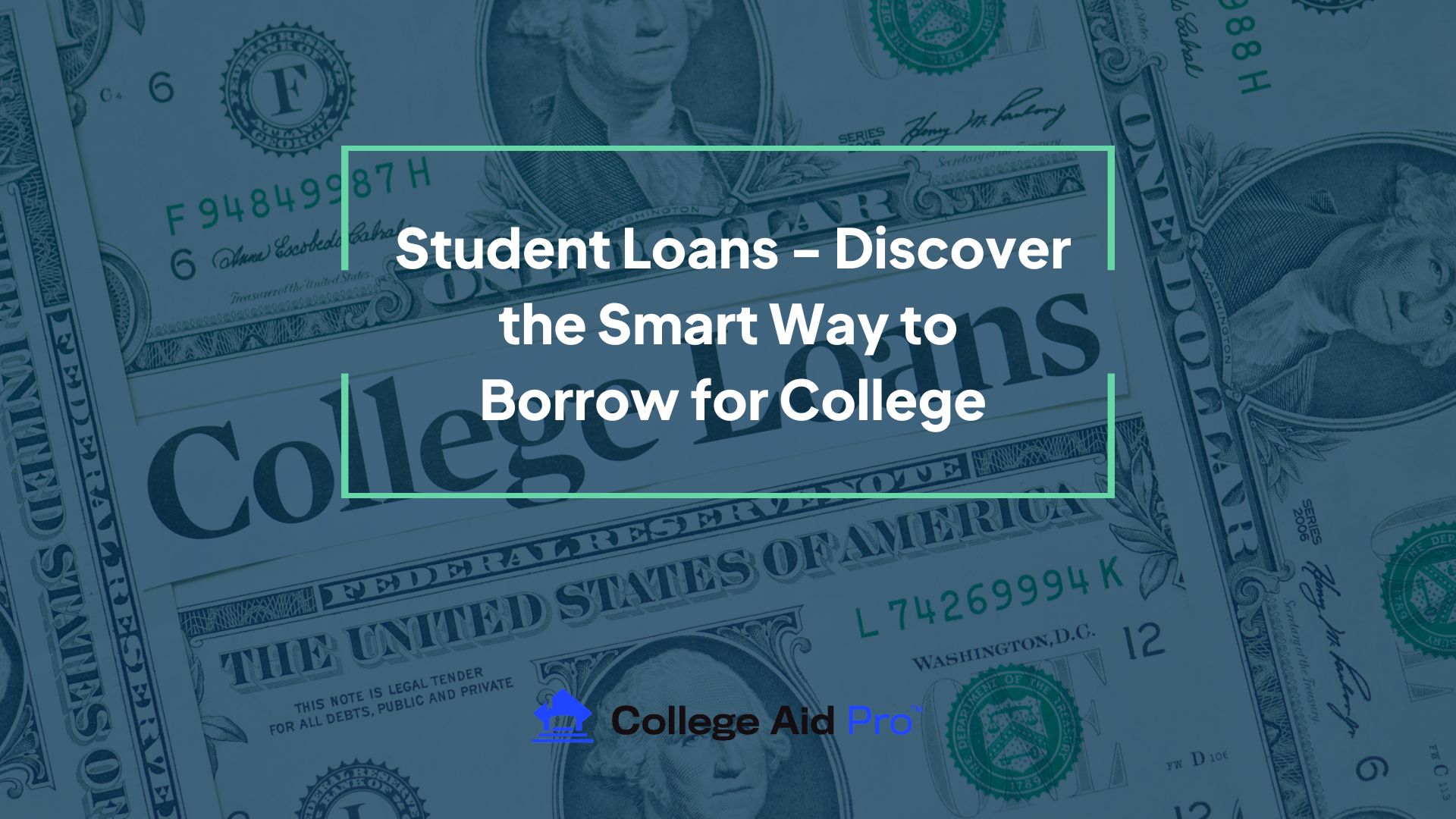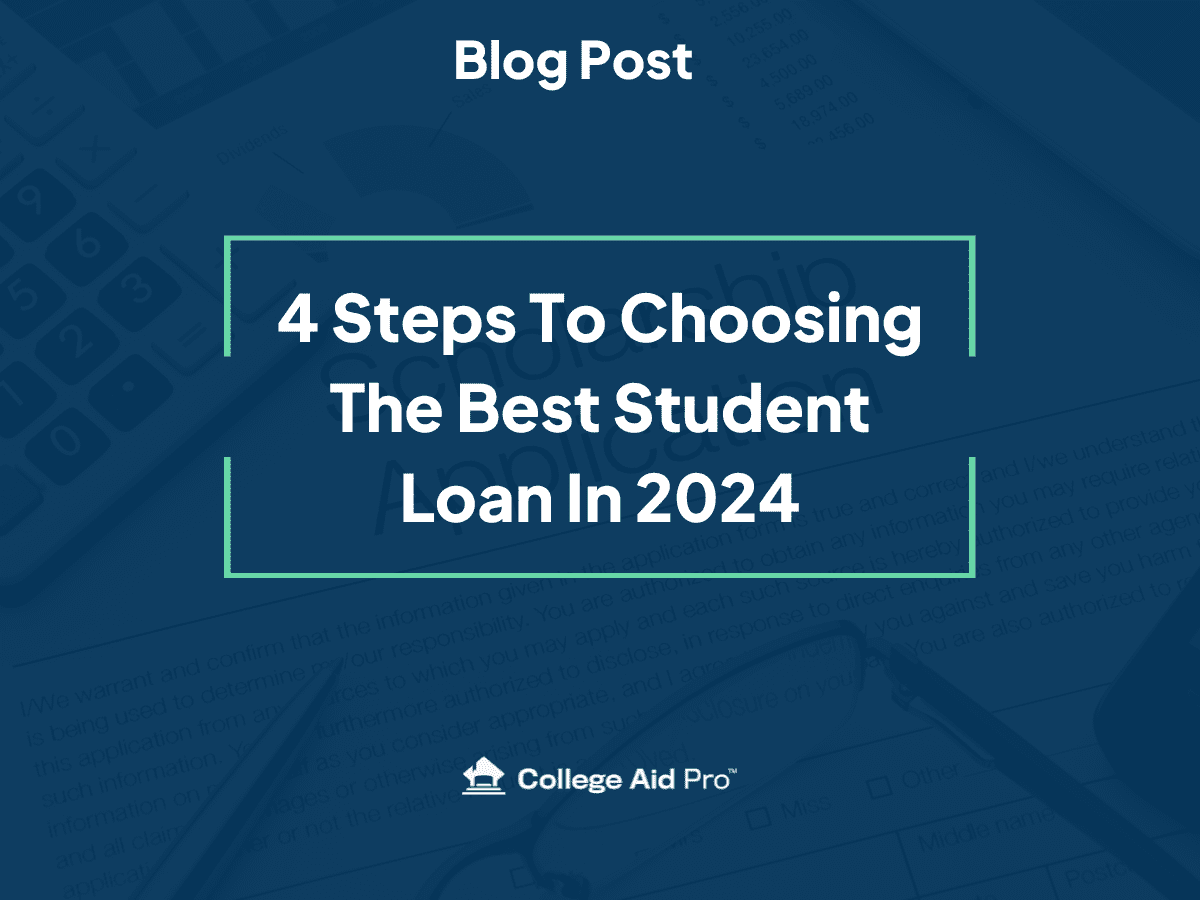Imagine it – your child applies and gets accepted to their dream school AND is offered a full ride scholarship! You pay nothing out of pocket, your son or daughter is set for college. You go back to sleeping through the night, throw away all loan program information, and no longer worry about how you are going to pay the college bill. This is the perfect ending to your child’s high school career, but for the majority and by majority I mean 98% of us, this is NOT reality, it’s a fairy tale.
The truth is that most college-bound students and their families will face a funding gap between what they can afford to pay out of pocket for school combined with grants and scholarships, and the final net cost of attendance. This funding gap can be bridged with student loans. However, it’s important that families choose the right student loan program for their unique situation.
Let’s dive into what student loan programs are out there, and what families need to know about borrowing.
Student Loan Timeline
Most colleges issue fall semester bills in July, and they’re typically due in August. Spring semester bills are issued in November and are due in December. If you know ahead of time that you will need student loans to cover your funding gap, you’ll need to have them in place by early to mid July for fall, and early to mid November for spring. If you plan to enroll in a monthly payment plan rather than paying your bills in full, you may need to have your plan in place earlier – closer to June 1st (when many payment plans begin).
Student loan providers usually take between 1-3 days to process an application and issue a disbursement.
Understanding Student Loans
There is no one-size-fits-all approach to student loan borrowing. Your family will need to evaluate your unique needs and financial situation to determine which program and loan provider is best for you.
Comparing the details of each loan type can help you to gain a better understanding of student loan borrowing and make empowered decisions about which loan(s) to secure:
| Federal Direct Student Loan | Federal Parent PLUS Loan | Private Student Loans | State Loans | |
| What is it? | Loans made to eligible undergraduate, graduate, & professional students | Loans made to eligible parents of undergraduate, graduate, & professional students | Loans from a private provider, such as a bank, credit union, state-based or state-affiliated organization, or a company that specializes in providing student loans | Loans through state of residence and/or state in which student is attending college |
| Interest Rate? | 6.53% Direct federal loans Fixed as of July 1, 2024
8.08% Grad student direct loans Fixed as of July 1, 2024 |
9.08% as of July 1, 2024 | 1.12% – 14.5% Fixed/Variable depending on the loan | 2.99% – 8% Fixed (varies by state) |
| FAFSA submission required? | Yes | Yes | No | Yes/No (varies by state) |
| Credit Criteria? | None | Must not have adverse credit | Borrowers generally need to have a credit score of 680 or higher. Debt-to-income ratio analysis. Actual credit requirements will vary among lenders. | Varies by state. Credit check required. |
| Summary | The Federal Direct Student Loan (FDSL) is the most common type of financial aid from the US Government. In general, loans are either subsidized or unsubsidized. Over the four years of college (undergrad), there is a total of $27,000 offered, & repayment begins 6 months after graduation. This is a “use it or lose it” loan, & can’t be used retroactively each year the student is enrolled. | The PLUS loan is the most lenient in terms of credit worthiness, along with the ease of application. If credit is a consideration this can be a good option. The PLUS is widely available & has flexible repayment options. The interest rate and fees might make the PLUS loan more expensive than a private parent loan for some borrowers. | Getting a private parent loan from a bank or lending institution may make more sense for some parents, as the cost of borrowing could be lower than the PLUS loan.
Private parent loans will require the borrower to pass a relatively stringent credit test. |
Not all state have loan programs but we recommend doing your homework while shopping for loans. Borrowers can be rewarded with lower fixed rates should they choose full repayment or interest only repayment plans. Also, credit worthiness is more strict and there is less consumer protection. |
| Pros | -Lower, fixed rates
-No need for credit checks -No need for co-signers or guarantors -Repayment begins after graduation -Demonstrated need qualifies for subsidized loans -Flexible repayment plans -Loan forgiveness for some jobs -No pre-payment penalties |
-Approval/Denial granted instantaneously
-Deferment option while student in school (interest accrues) -Most flexible repayment plans -Consolidation offered -Forgiveness programs for certain jobs -Best consumer protection -Most lenient credit requirements -No pre-payment penalties |
-No loan origination fee
-Strong credit borrowers can get lower rates that the PLUS loan -Cost of borrowing could be lower than PLUS -Rate discount for auto-pay -Option for co-signer release |
-Approval/Denial usually granted in 24-48 hours
-Lower rates based on repayment terms -Fixed rates can be lower than PLUS or private loan rates -Student has equal responsibility for loan -Multiple repayment options -Can elect to defer repayment (at a higher rate) –-MA, RI, & IA have state programs that are open to all borrowers regardless of state of residence or where the student will attend college |
| Cons | -Origination fee 1.057%
-Interest accrues on unsubsidized loans while student is in school |
-Origination fee 4.228%
-Only in parent’s name for the life of the loan |
-Weaker credit will likely have higher rates than the PLUS loan | -NOT offered in all states
-Higher rate for deferment -Little flexibility in changing repayment plans -Most states don’t offer consolidation options -Parent remains on loan for life of loan as co-borrower -Loan origination fee ~3% (varies by state) |
Federal Direct Student Loans
This is where borrowing begins! Unless the cost of college is fully covered for all four years, we recommend each student take advantage of the Federal Direct Student Loan, even if borrowing is not needed until the later years of school.
In order to secure the full $27,000 of this program, the student must secure a FDSL each year that they’re enrolled. These funds are awarded as such:
- $5,500 Freshman Year
- $6,500 Sophomore Year
- $7,500 Junior Year
- $7,500 Senior Year
There are two categories of the FDSL:
- Direct Subsidized Loans
- Direct Unsubsidized Loans
Direct subsidized and unsubsidized loans are both for college-bound students (not parents, and not graduates looking to consolidate). Subsidized loans generally:
- Are geared towards students who demonstrate financial need
- Have lower student loan borrowing limits
- Don’t accrue interest until the student graduates (the US Department of Education pays the interest while students are enrolled)
- Only available for undergraduate students
Unsubsidized loans generally:
- Are not subject to financial need stipulations
- Have higher borrowing limits
- Accrue interest while the student is in school
- Are available for undergraduate, graduate, and professional degrees
All of these loans are provided directly by the U.S. Department of Education.
Federal Parent Plus Loan
Direct PLUS loans are for the parents of college-bound students, and are provided by the U.S. Department of Education. The PLUS loan is a federal government program for parents that need to borrow money for their sons or daughters going off to college, or for graduate level schools, the students themselves borrow the PLUS loan. This is a pretty popular program that gets mixed reviews, but can be effectively used to help families successfully fund their college costs.
To be eligible for a PLUS Loan, you must:
- Be the parent of a dependent undergraduate student enrolled at least half-time at an eligible school
- Have a good credit history
- Meet the eligibility requirements for all federal student loans.
Through the PLUS loan program, parents can borrow up to the cost of attendance for their student minus any other financial assistance received.
Private Loans
Private loans are offered by third party lenders, and are less flexible than federal student loans.
Private loans generally:
- Are offered by banks or credit unions
- Have either fixed or variable interest rates
- Are credit based, not need based
- Offer the option to apply with a consignor
- Can be granted for a range of borrowing amounts, low or high
Students and their parents often look to private loans if they are already borrowing the maximum federal loan amount and have not received grants or scholarships, but still have a funding gap.
Compare private student loans with our new loan comparison tool by clicking here.
State Loans
Many states offer some sort of state loan program for their residents or students attending college in their state. Check with your state or the state where your student will be attending college to see what kind of state loan options you can take advantage of. If your state doesn’t offer a state loan program, there are some state loan programs that are open to residents of any state. The rates may be a bit higher if you are not a resident, but they may still be options to check out and compare.
Compared to borrowing Parent PLUS loans from the U.S. Department of Education, state or private loans can often have lower fixed interest rates. Keep in mind that state loans, while more flexible in some ways, can be more strict when it comes to running credit checks, and offer more rigid repayment plans.



